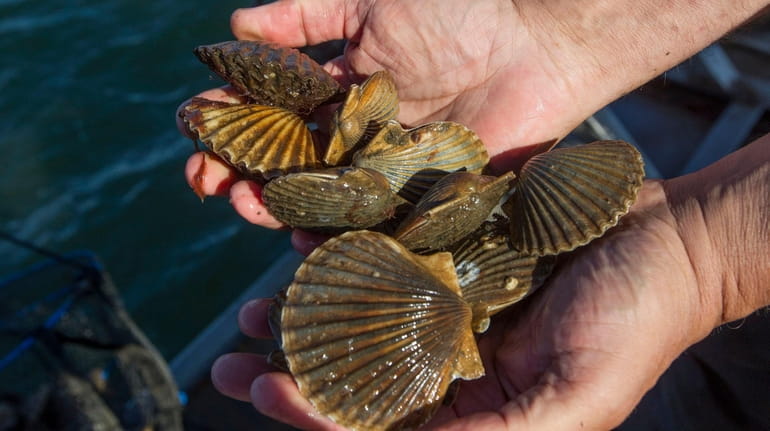Study finding early signs of hope for Peconic scallop fishery

A handful of pulled scallops from the Peconic Bay in Orient in 2012. Credit: Randee Daddona
Scientists studying the early stages of bay scallop growth are finding encouraging signs this year, after two years of scallop die-offs that recently led the federal government to declare a disaster in the Peconic Bay fishery.
Scallops can lay up to 2 million eggs when they spawn in the period of June to August, and this year’s larval scallops will go on to make up the breeding stock for next summer’s spawn.
An expanded survey of scallops being funded by New York State and conducted by the Cornell Cooperative Extension and Stony Brook University is finding higher levels of larval scallops than has been seen in 17 years, said Stephen Tettelbach, a shellfish ecologist for Cornell.
"It’s way beyond anything we’ve ever seen in terms of larval settlement," Tettelbach said. "It shattered all records we’ve seen in 17 years by far."
Just as encouraging, Tettelbach said, researchers haven’t seen the summer die-offs of adult scallops that they they saw in the previous two years, a die-off that amounted to 50% of the population by the end of June and 100% in some areas by the end of July. "So far we haven’t seen any big die-offs," he said.
While adult scallops in 2020 and 2019 saw record die-offs, essentially ending the harvest season for many scallopers, the adult scallops were able to spawn before they died and those larval scallops were seen in large numbers as juveniles over the past year. As adults, they will become the 2021 scallop harvest — if they survive. Scallops typically live for a year, sometimes two.
"There were a lot of juveniles last year," Tettelbach said. "They are this year’s adults. So far they’re doing OK."
Scientists still don’t know for sure what caused the die-off. Tettelbach said primary theories include rising water temperatures during the spawning season, which can stress the scallops, as well as the presence of a killing pathogen, or predators such as cow-nosed rays that feed on scallops and have been seen in large numbers in local waterways in recent years.
Cornell has vastly expanded its monitoring of the scallops and the conditions in which they live to see if they can determine what specifically caused the die-off, Tettelbach said.
Scientists looking to further the studies may get help from the federal government after the Commerce Department this month declared the Peconic Bay scallop fishery one of four disaster areas across the country. Sen. Chuck Schumer (D-N.Y.) had written to the commerce secretary last year requesting the declaration, as did New York State.
Schumer’s office said the declaration will lead to funding for the fishery that can be used to provide grants to fishermen and communities, job retraining and low-interest loans. No specific level of funding has yet been announced. The funding can also be used to pay for research, habitat restoration and fishing capacity reduction programs.

Updated now Newsday travel writer Scott Vogel took the ferry over to Block Island for a weekend of fun.

Updated now Newsday travel writer Scott Vogel took the ferry over to Block Island for a weekend of fun.

